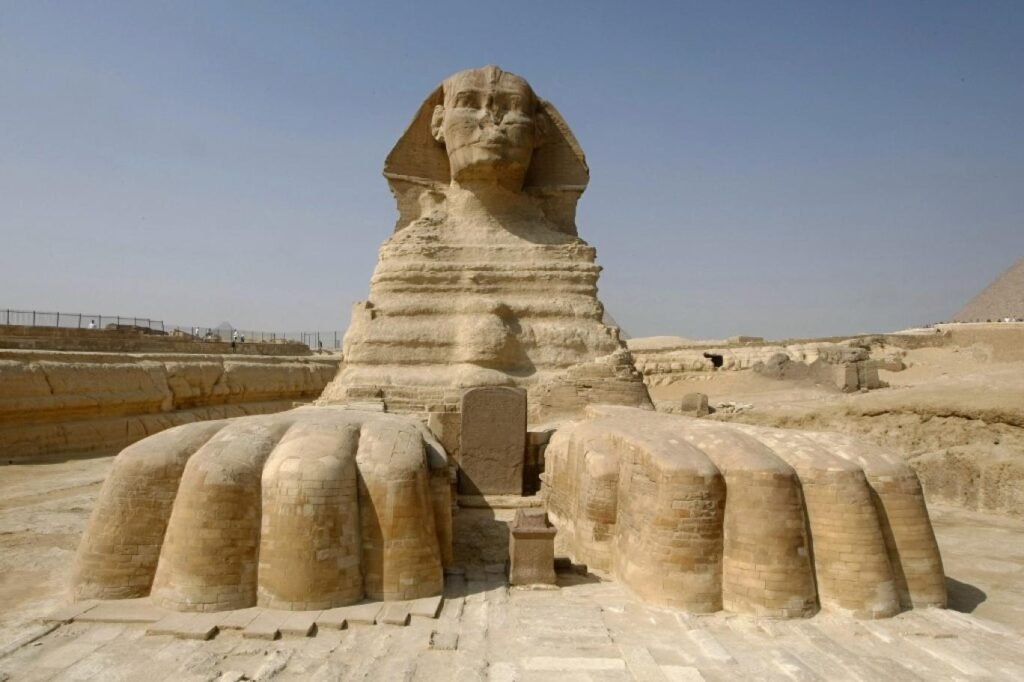
Egypt is not only about the Nile and the temples—it is also home to one of the most iconic and mysterious monuments in the world: the Great Sphinx of Giza. Standing proudly on the Giza Plateau, this colossal guardian attracts travelers, historians, and dreamers with its timeless aura, ancient secrets, and breathtaking presence. This article will explore the wonders of the Great Sphinx and why it should be on your Egypt travel list.
The Sacred Setting: The Giza Plateau and Pharaoh Khafre
According to most scholars, the Great Sphinx was carved during the reign of Pharaoh Khafre (around 2500 BC). Positioned directly in front of Khafre’s pyramid, the Sphinx was designed as a guardian of the royal necropolis. Its human head symbolizes wisdom, while its lion’s body represents strength and power. Facing east, it greets the rising sun each morning, embodying rebirth and eternity.
A Monument with Ancient Treasures
The Great Sphinx is one of the largest and oldest statues in the world. Visitors can admire:
- The colossal body carved from natural limestone, stretching 73 meters long and 20 meters high.
- The enigmatic face, believed to represent Pharaoh Khafre.
- The Dream Stele, placed between its paws by Pharaoh Thutmose IV, recounting the famous legend of the Sphinx promising him kingship if he cleared away the desert sands.
- Ongoing archaeological studies that continue to reveal secrets about its construction and purpose.
Spiritual and Cultural Significance
The Sphinx is more than a monument—it is a symbol of Egypt’s eternal spirit. Ancient Egyptians saw it as “Horus in the Horizon,” a divine protector. For modern visitors, standing before the Sphinx is a moment of reflection, connecting with thousands of years of history, mythology, and human creativity.
Exploring the Giza Plateau
Beyond the Sphinx, the Giza Plateau offers incredible wonders:
- The Great Pyramid of Khufu, the last surviving Wonder of the Ancient World.
- The Pyramid of Khafre and the Pyramid of Menkaure.
- The Valley Temple, where rituals and ceremonies once took place.
- Panoramic views of Cairo blending ancient history with modern life.
Egyptian Hospitality at Giza
Visiting the Sphinx is not only about history—it’s also about experiencing Egyptian warmth. Local guides share stories, legends, and insights passed down through generations. Visitors can enjoy traditional meals, shop for handmade crafts, and immerse themselves in the vibrant culture surrounding the site.
Safety and Accessibility
The Great Sphinx is part of the Giza Plateau, a secure and well-maintained UNESCO World Heritage Site. It is easily accessible from Cairo, just 30 minutes by car. Guided tours ensure a smooth experience, with professional guides offering historical context and cultural insights.
Frequently Asked Questions (FAQs)
Q1: Why is the Great Sphinx famous?
It is the largest monolithic statue in the world, symbolizing wisdom and strength, and guarding the pyramids for over 4,500 years.
Q2: Can visitors get close to the Sphinx?
Yes, visitors can view the Sphinx from designated areas on the Giza Plateau, with excellent photo opportunities.
Q3: What is the best time to visit the Sphinx?
From October to April, when the weather is cooler and more comfortable for exploring.
Q4: How do I get to the Sphinx?
It is located on the Giza Plateau, about 30 minutes from downtown Cairo. Tours and transportation are widely available.
Q5: Is it safe to visit the Sphinx?
Yes, the site is secure and regularly visited by millions of international travelers each year.
Conclusion
Visiting the Great Sphinx of Giza is more than a trip—it is a journey into mystery, history, and culture. From its colossal form to the legendary Dream Stele, every detail tells a story that has shaped civilizations. Combined with the grandeur of the pyramids and the warmth of Egyptian hospitality, the Sphinx offers an unforgettable experience for travelers seeking both wonder and connection.
